Bulletin – June 2012 Banknote Quality in Australia
- Download the article 946KB
Abstract
The Reserve Bank aims to keep the quality of banknotes in circulation high to ensure that they meet the needs of the public and to make it more difficult for counterfeits to be passed or remain in circulation. This article discusses the quality of banknotes in Australia and Reserve Bank initiatives that have improved the quality of banknotes in recent years.
Introduction
Under the Reserve Bank Act 1959, the Reserve Bank has responsibility for the production, issue, reissue and cancellation of Australia's banknotes. The key objective of the Bank in meeting this legislative responsibility is to maintain public confidence in Australia's banknotes. There are three facets to this. First, the Bank ensures that there are sufficient banknotes to meet demand. Second, it attempts to minimise the risk of counterfeiting. Finally, it strives to ensure that the banknotes in circulation meet the functional requirements of the public. More precisely, the banknotes must be acceptable to retailers, and be able to be used in banknote equipment such as automated teller machines (ATMs) and ticketing machines.
A key factor relevant to the second and third of these goals is the quality of banknotes in circulation. The higher the quality of banknotes, the more difficult it is for counterfeits to be passed. Furthermore, better-quality banknotes are more likely to be readily accepted by retailers, and are less likely to cause problems in ATMs and other banknote equipment.
This article discusses the Bank's approach to monitoring the quality of banknotes in circulation. It commences with a brief discussion of the banknote distribution arrangements in Australia and how the Bank encourages the cash industry to improve the quality of banknotes in circulation. It then presents data on banknote quality and the impact of a Bank incentive scheme.
Banknote Distribution and Processing
The private sector plays an important role in the banknote distribution and processing system in Australia. The Reserve Bank is a wholesaler of banknotes and ensures that the main commercial banks have sufficient access to the Bank's banknote holdings. Other authorised deposit-taking institutions (ADIs) and retailers can purchase banknotes as required, in the secondary market. Although they do not generally hold title to the banknotes, cash-in-transit companies (CITs) carry out the majority of banknote distribution and processing activities on behalf of ADIs and retailers. As such, the CITs are the linchpin in the arrangements for improving the quality of banknotes in circulation.
CITs collect banknotes from one of the Bank's two distribution sites. The CITs then distribute these banknotes from their depots to ADIs and retailers throughout Australia (Figure 1). Banknotes that are surplus to the requirements of the public and ADIs are returned by ADIs and larger users of banknotes to CIT depots. At the depots, they are sorted according to their quality on the basis of any damage associated with regular wear and tear. Banknotes that are deemed to be fit are returned to circulation, while the remainder are returned to the Bank for verification and destruction.
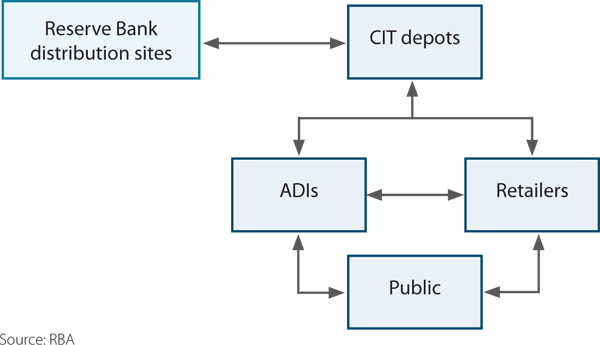
When deciding whether a banknote is fit for circulation, the CITs must consider the needs of their customers; it is in their interests to ensure that banknotes are of sufficient quality to satisfy their retail customers and are able to be used in their banknote equipment. There is a risk, however, that these private sector agents may sort to a lower quality level than the Bank considers appropriate, since it may cost them less to recirculate lower-quality banknotes than to return them to the Bank for replacement with new banknotes. Ideally, the Bank would like all banknotes in circulation to have no mechanical defects (such as holes, tears and adhesive tape) or inkwear, which is the degree to which the print on the banknote has worn.[1] The private sector, on the other hand, may be willing to accept a lower quality of banknotes than the Bank.
For these reasons, in 2006 the Bank introduced the Note Quality Reward Scheme (NQRS). The NQRS provides a financial incentive to members of the cash industry responsible for banknote distribution and processing, to encourage them to sort banknotes in a way that ensures that only high-quality banknotes are put back into circulation (see ‘Box A: Note Quality Reward Scheme’ for further details about the scheme).
Banknote Quality in Australia
Because the Bank aims to maintain a high quality of banknotes in circulation in Australia, it must be able to measure and monitor that quality. To this end, the Bank operates a commercial cash sampling program. At the request of the Bank, CIT depots regularly set aside samples of banknotes deposited by a range of commercial customers (such as supermarkets, small businesses, post offices and bars) before any sorting takes place. The samples are sent to the Bank to measure their quality, and the data collected are used to provide an indication of the quality of banknotes in circulation.
Denominational quality
The Bank's data suggest that the quality of banknotes in circulation in Australia is high: around 98 per cent of the banknotes obtained through the commercial sampling program are categorised as good quality (Graph 1). There is, however, some difference in quality across the five different banknote denominations in circulation. In particular, the quality of $5 and $10 banknotes, while still fairly high, deteriorates more rapidly than the quality of the higher denominations.
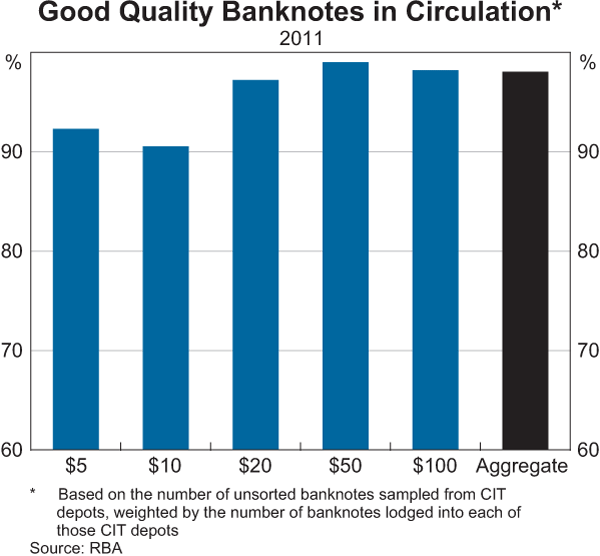
Although all Australian banknote denominations have the same features, and are produced using the same materials and to the same quality specifications, there are two main reasons why the quality of the lower denominations in circulation may differ from that of the higher value banknotes.
First, there are differences in how each denomination is used. The median value of cash payments in Australia is around $12 (Bagnall and Flood 2011), which suggests that $5, $10 and $20 banknotes are more likely to be used in cash transactions, both as a means of payment and as change. In contrast, $50 and $100 banknotes are rarely given as change. The $100 banknote, in particular, tends to be used as a store of value rather than to conduct transactions, and is not typically dispensed in ATMs. It is therefore reasonable to assume that, over time, lower denomination banknotes will be handled more frequently and hence develop more inkwear and defects.
Second, there are differences in how frequently banknotes are returned to a CIT depot, which is when any poor-quality banknotes are withdrawn from circulation. On average, $20 and $50 banknotes are estimated to pass through a CIT depot once every two or three months, whereas $5 and $10 banknotes tend to circulate within the hands of the public for almost twice as long before they pass through a depot for sorting (Graph 2). These differences are due to a combination of factors, including how each banknote denomination is used by the public and whether it is dispensed in ATMs.
These observations are supported by evidence that inkwear is more common in lower denomination banknotes (Graph 3). As inkwear results from the gradual abrasion of the banknote print as the banknote is handled over its life, the extent of inkwear provides an indication of how many times a banknote has been handled and how long it has been in circulation. The fact that $5 and $10 banknotes have the highest rates of inkwear suggests that these denominations are handled more frequently and are not returned to CIT depots as often for removal from circulation.
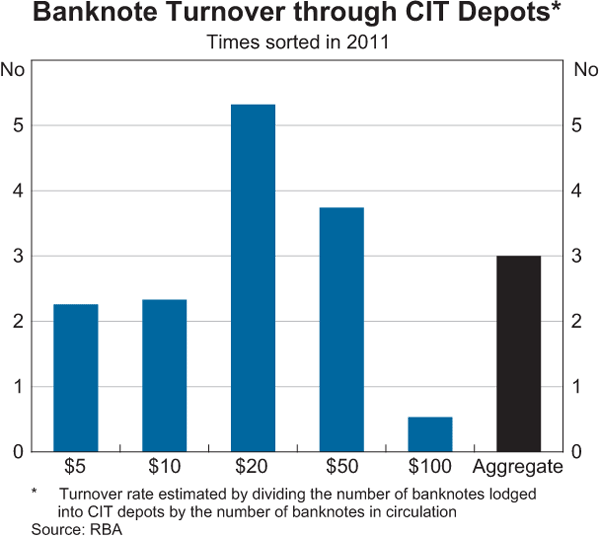

Similar trends in denominational quality have been observed overseas. In New Zealand, for example, the $5 banknote has been identified as being the poorest quality denomination in circulation. A public survey commissioned by the Reserve Bank of New Zealand found that the majority of retailers and consumers surveyed were dissatisfied with the quality of $5 banknotes (Nielsen 2011). The Bank of England has also stated that its lowest denomination, the £5 banknote, is generally of lower quality than the higher denominations of banknotes in circulation. Similar factors to those seen in Australia, such as more frequent transactions made with low denominations, and the lower turnover of denominations that are not dispensed by ATMs, are believed to be the primary influences on banknote quality (Bailey 2009; Cleland 2011).
Regional quality
Another of the Bank's objectives is to ensure that banknote quality is high across Australia, regardless of proximity to large population centres. Combining the Australian Bureau of Statistics (ABS) Remoteness Structure with the Bank's commercial cash sampling data indicates that the quality of banknotes in the major cities is marginally higher than in regional and remote areas, but the proportion of good quality banknotes is consistently high across Australia (Graph 4).

Impact of the Note Quality Reward Scheme
The private sector plays a significant role in sorting banknotes in circulation in Australia. Under the current distribution arrangements, cash industry participants determine the way in which they sort banknotes into those fit for circulation and those that need to be returned to the Bank for destruction. There is a risk, however, that a participant will sort banknotes to a lower quality standard than the Bank considers appropriate to achieve its policy objectives. For this reason, the Bank introduced the NQRS in September 2006 to encourage higher sorting standards in the cash industry. Private sector participants in the NQRS are the CITs and the main commercial banks.
Even if the majority of banknotes in circulation are of high quality, there is a risk that a small number of poor-quality banknotes can adversely affect the public's general perception of banknote quality. In order to minimise this risk, the Bank's NQRS focuses on raising the standard of the poorest quality banknotes. Accordingly, for banknotes sampled under the NQRS, the Bank measures the average quality of the worst 15 per cent of banknotes in a sample – a measure known as the sample ‘Quality Score’. The magnitude of the payment or penalty applied to the NQRS participants is determined by this Quality Score.
Since the NQRS was introduced in September 2006, average Quality Scores, and by implication the sorting thresholds used by participants, have improved for all five denominations (Graph 5). It took less than one year for the average Quality Score for $5 and $10 banknotes to move from the neutral to financial reward zone; other denominations also saw a rapid improvement in their average Quality Score. This improvement has been sustained for several years, with average Quality Scores sitting well within the range required to receive a financial reward.

As CIT depots account for around 80 per cent of banknote sorting under the NQRS, the standards to which they sort can have a considerable impact on banknote quality.[2] Since the introduction of the NQRS, there has been a considerable shift in the distribution of CIT depot sample Quality Scores toward the higher end of the quality scale. In fact, the distribution of the Quality Scores for the 60 or so regularly sampled CIT depots has improved for all denominations (as shown for the $5 and $50 banknotes in Graph 6).
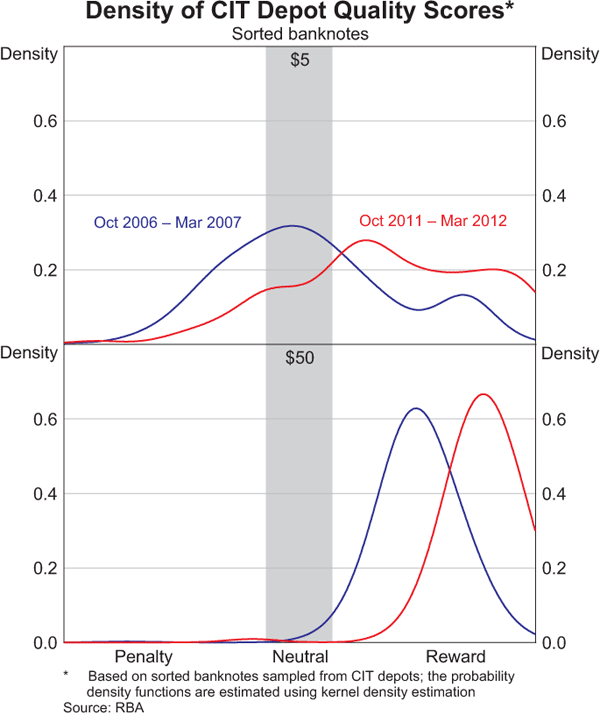
Another way to measure how effectively CIT depots sort banknotes is to compare data on the quality of banknotes sampled from the depots before and after sorting. The Bank's commercial cash sampling data measure the quality of banknotes entering each CIT depot before sorting, while NQRS data measure the quality of banknotes at each depot after sorting; differences between the two data series provide an indication of how effectively CIT depots sort banknotes and, by extension, the value added by the NQRS.
The greatest improvement in Quality Scores at the CIT depots sampled, from unsorted to sorted banknotes, is seen in the lower denominations. The sorted $5 Quality Scores at around 75 per cent of CIT depots sampled are sufficiently good to receive a reward under the NQRS (Graph 7). Before sorting, only 30 per cent of the depots have $5 Quality Scores in the reward range. For the $50 denomination, the improvement in Quality Scores due to sorting is not as significant, but is still a clear improvement. The larger spread in Quality Scores for the $5 denomination reflects a larger variance in the quality of $5 banknotes, both before and after sorting.
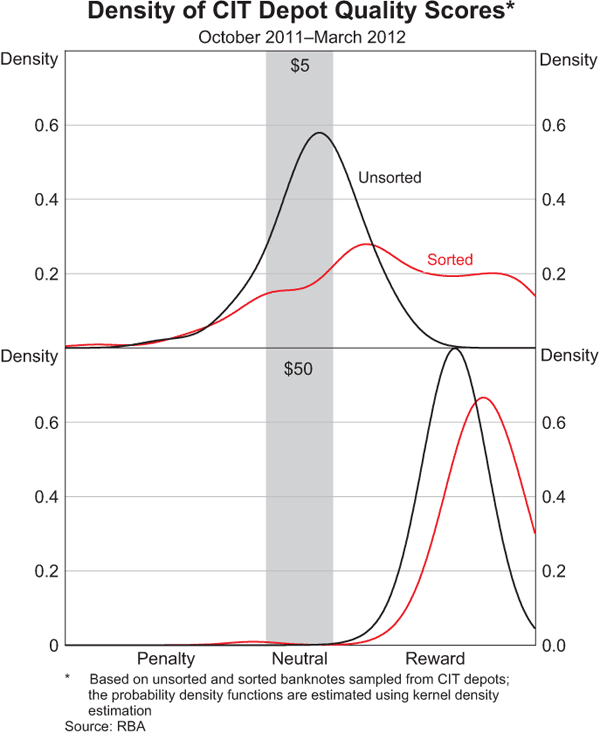
Conclusion
The vast majority of banknotes in circulation in Australia are of very good quality. Nevertheless, because most banknote sorting is conducted by private sector agents and, in particular, CIT depots, the Bank regularly monitors the standard of their sorting. The Bank has been able to provide incentives to cash industry participants to encourage them to only put good-quality banknotes back into circulation after sorting. This helps to maintain the quality of banknotes in circulation which, in turn, helps to maintain a high level of public confidence in Australia's banknotes.
Box A: Note Quality Reward Scheme
Prior to introducing the Note Quality Reward Scheme (NQRS), the Reserve Bank evaluated a number of options for improving banknote quality sorting by the private sector. The Bank's objective was to introduce a scheme that would ensure a sustained improvement in the quality of all banknote denominations across Australia, promote enduring behavioural changes in the banknote handling industry, and encourage the evolution of banknote sorting technology at cash-in-transit (CIT) depots.
The first option considered was a quota-based scheme, under which the Bank would specify the number of unfit banknotes to be periodically returned to the Bank. The second was an infrastructure-based model, which would have involved the Bank prescribing the type of sorting equipment to be installed and operated at CIT depots. The third model considered was a scheme of payments and penalties designed to encourage CIT depots to invest in sorting technology that complemented their broader business strategies. The Bank decided that the first two options would not promote the desired long-term behavioural changes in the banknote handling industry, nor would they encourage the development of the sorting technology used at CIT depots.
Under the third model, which became known as the NQRS, the Bank regularly samples and measures the quality of banknotes that have been sorted by scheme participants. Because the focus of the NQRS is on improving the standard of the poorest quality banknotes in circulation, the average quality of the worst 15 per cent of banknotes in each sample is calculated. This statistic is known as the sample ‘Quality Score’.
Performance credits and debits are allocated depending on the Quality Scores of the banknotes sampled. A credit is paid for a sample with a good Quality Score and a debit is levied for a sample with a poor Quality Score. The magnitude of the financial payment or penalty is proportional to the Quality Score of the banknote sample. There is also a ‘neutral’ Quality Score range, where no credit or debit is applied. This system of credits and debits was agreed between the Bank and the industry, and reflects agreed minimum quality standards.
Although the Bank does not have direct control over the cash handling industry's banknote sorting, it has used the NQRS to encourage participants in the private sector to invest in banknote sorting equipment. The investment in this equipment plays an important part in maintaining the quality of banknotes in circulation in the long term.
Footnotes
The authors are from Note Issue Department. [*]
See the Bank's banknote sorting guide for further details on the ways in which banknotes can become worn or damaged, and what the public can do with a heavily worn or damaged banknote. Available at http://banknotes.rba.gov.au/assets/pdf/sorting-guide.pdf [1]
The main commercial banks account for the remaining 20 per cent of banknotes sorted under the NQRS. [2]
References
Bagnall J and D Flood (2011), ‘Cash Use in Australia: New Survey Evidence’, RBA Bulletin, September, pp 55–62.
Bailey A (2009), ‘Banknotes in Circulation – Still Rising. What Does this Mean for the Future of Cash?’, Speech at the Banknote 2009 Conference, Washington DC, 6 December.
Cleland V (2011), ‘Challenges in Note Circulation – Availability and Quality of Low Denomination Notes’, Speech at the International Commercial Cash Operations Seminar, Europe, the Middle East and Africa: The Currency Cycle Conference, Barcelona, 21 March.
Nielsen (2011), ‘RBNZ Bank Notes Survey 2010 Retailers’, Report prepared for Reserve Bank of New Zealand.